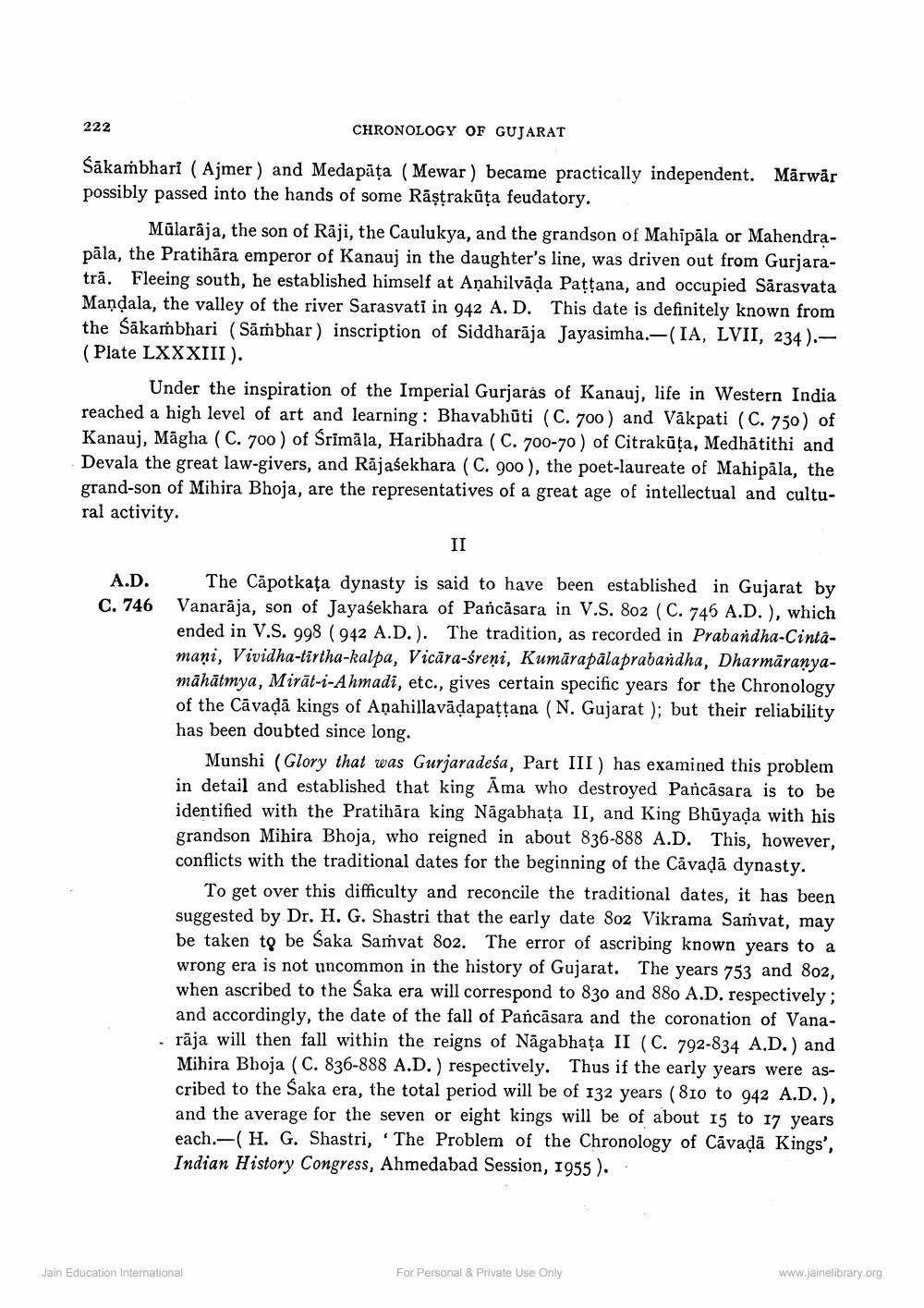________________
222
CHRONOLOGY OF GUJARAT
Śākambhari ( Ajmer) and Medapāța ( Mewar ) became practically independent. Märwär possibly passed into the hands of some Rāstrakūța feudatory.
Mūlarāja, the son of Rāji, the Caulukya, and the grandson of Mahipāla or Mahendrapāla, the Pratihära emperor of Kanauj in the daughter's line, was driven out from Gurjaratrá. Fleeing south, he established himself at Aşahilvāda Pattana, and occupied Sārasvata Mandala, the valley of the river Sarasvati in 942 A. D. This date is definitely known from the sākambhari (Sambhar) inscription of Siddharāja Jayasimha.-(IA, LVII, 234).(Plate LXXXIII).
Under the inspiration of the Imperial Gurjarás of Kanauj, life in Western India reached a high level of art and learning : Bhavabhūti (C. 700) and Vākpati (C. 750) of Kanauj, Māgha (C. 700 ) of Srimāla, Haribhadra (C. 700-70 ) of Citrakūta, Medhātithi and Devala the great law-givers, and Rājasekhara (C. 900), the poet-laureate of Mahipala, the grand-son of Mihira Bhoja, are the representatives of a great age of intellectual and cultural activity.
II
A.D. The Cāpotkața dynasty is said to have been established in Gujarat by C. 746 Vanarāja, son of Jayasekhara of Pancāsara in V.S. 802 (C. 745 A.D.), which
ended in V.S. 998 ( 942 A.D.). The tradition, as recorded in Prabandha-Cintamaņi, Vividha-tirtha-kalpa, Vicāra-śreni, Kumārapalaprabandha, Dharmāranyamāhātmya, Mirāt-i-Ahmadi, etc., gives certain specific years for the Chronology of the Cāvadā kings of Anahillavādapattana (N. Gujarat ); but their reliability has been doubted since long.
Munshi (Glory that was Gurjaradeśa, Part III) has examined this problem in detail and established that king Ama who destroyed Pancāsara is to be identified with the Pratihāra king Nāgabhața II, and King Bhūyada with his grandson Mihira Bhoja, who reigned in about 836-888 A.D. This, however, conflicts with the traditional dates for the beginning of the Cāvaļā dynasty.
To get over this difficulty and reconcile the traditional dates, it has been suggested by Dr. H. G. Shastri that the early date 802 Vikrama Samvat, may be taken to be saka Samvat 802. The error of ascribing known years to a wrong era is not uncommon in the history of Gujarat. The years 753 and 802, when ascribed to the Saka era will correspond to 830 and 880 A.D. respectively;
and accordingly, the date of the fall of Pancāsara and the coronation of Vana. rāja will then fall within the reigns of Nāgabhaţa II (C. 792-834 A.D.) and
Mihira Bhoja (C. 836-888 A.D.) respectively. Thus if the early years were ascribed to the Saka era, the total period will be of 132 years ( 810 to 942 A.D.), and the average for the seven or eight kings will be of about 15 to 17 years each.-( H. G. Shastri, “The Problem of the Chronology of Cāvadā Kings', Indian History Congress, Ahmedabad Session, 1955).
Jain Education Intemational
For Personal & Private Use Only
www.jainelibrary.org




